Adobe creative cloud is a creator’s paradise and is a steal if you’ve got the use cases for each one (or most) of its apps.
Adobe is generally great in what it does, which makes it the first choice of many industry pros.
The ones who deny its superiority over others do this mostly because of its price tag and unavailability of a powerful free tier for all its applications.
And they are partly correct. It’s expensive and overkill for beginners.
However, subscribing to the Adobe Creative Cloud is an excellent option if you use more than a few Adobe apps. We’ll come to that. But first, it’s important to check out what Adobe’s app suite brings to the table.
Adobe Creative Cloud
Creative Cloud is Adobe’s suite of applications and cloud services to help you with photo and graphic editing, video creation, UI and UX design, and more.
Currently, the package has over 20 applications, including:
- Photoshop
- Illustrator
- Premiere Pro
- Adobe Express
- Acrobat pro
- InDesign
- After Effects
- Animate
- Audition, etc.
Besides, you get 100GB of cloud storage to access your projects anywhere.
This might be more than what you ask or need, but this is one of the best creative packages if you have the bandwidth to put them to work.
So, let’s dive deeper into this app suite and see what the apps offer individually.
Photoshop
For Adobe, Photoshop was one of the first apps that brought it into serious business. It became so successful that people often use its name synonymously with the process: this image looks photoshopped. (You bet!)

Just visiting Adobe’s Photoshop section tells you how powerful the package is. In addition, YouTube is host to countless Photoshop tutorials, thanks to its ever-expanding community.
In a nutshell, if you can do it with a paintbrush, it’s most likely possible with Adobe Photoshop.
Let’s check a few of its features:
- Modify background
- Object disappear
- Colorize
- Masking
- Sky replacement
In addition to its presets you can mesmerize your audience with Photoshop Brushes, including pencil, charcoal, and ink. This is much like digital painting and helps you go human to give it that much-needed personal touch.
There are many custom brushes and effects, helping you create something akin to a true canvas painting.
Finally, Photoshop isn’t limited to images. It works well with elementary video editing too.
Also read: Top Photoshop alternatives
Illustrator
Many users are confused between Illustrator and Photoshop. And while they share some capabilities, their use cases are entirely different.

Put simply, Photoshop works on raster images, while Illustrator is for the vector domain. Raster images are made of pixels and can look pixelated if zoomed in beyond a certain point.
However, vector art remains in perfect shape (for ex., sharp borders) irrespective of the size you stretch it to. This attribute makes vector a go-to format for logo design, animations, backgrounds, banners, posters, video game art, etc.
Currently, Adobe Illustrator comes bundled with Creative Cloud and has no separate subscription.
Also read: Best Illustrator alternatives
Acrobat Pro
This is one of the flagship Adobe products with a limited-featured forever free version.
The paid subscription packs an exhaustive list of things you can do with pdf; some of them are:
- Text and image editing
- eSign and request signatures
- Secure PDFs with passwords
- PDF comparison
- Share and comment
- Integrate cloud storage like Google Drive
- Merge, split, & compress
- Add audio, video, etc.

There are countless more functions that make Acrobat Pro a crucial tool for any document-heavy user or business.
In addition, it can convert other files created with other Adobe tools (Photoshop, Illustrator, and InDesign) into PDFs.
Also read: Things to consider while choosing Adobe Acrobat alternative.
Premiere Pro
This is a tool that has been used for ages by professional filmmakers. As with Photoshop, Premiere Pro also boasts a huge user base, ready to handhold beginners with how-to guides.
This truck is loaded with features that can help you create eyeball-grabbing effects with ease.
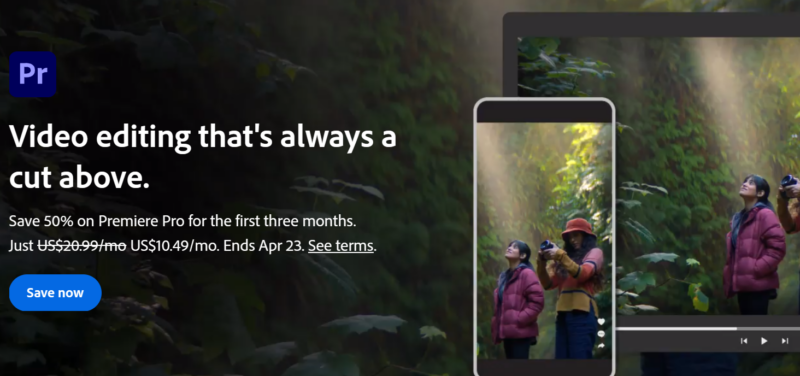
Some of the things you can do with Premiere Pro are:
- Animation & motion graphics
- AI-powered audio editing
- Color correction and grading
- Auto captions
- Collaboration
Besides, one can adjust a video to match perfectly to various platforms, which helps cut redundant work. Moreover, Adobe’s huge stock library gives you an upper hand with its graphics, effects, music, etc.
But since mastering any video editing application can be a grind, you get in-built tutorials.
It also supports auto-caption generation and native exporting to popular social platforms, including YouTube, Facebook, Twitter, etc.
Overall, it’s one of the best video editors in the market that’s backed by excellent support from Adobe.
Adobe Express
Adobe Express brings many tools for image, video, and document editing on the go. Most tools are available with a free Adobe account.

However, it’s not just about these file conversion and modification tools. It’s an ‘express’ method of creating attention-worthy content, including banners, logos, social posts, ads, etc.
Express is also backed by Adobe’s stock library for royalty-free assets, including images, font, etc.
But while most of the Adone Express is free, it also has a paid version. This unlocks all its media assets, premium tools & templates, one-click branding, and post-scheduling on social media.
InDesign
Adobe InDesign is for magazine people associated with print media. The idea is to create stunning covers and content for any publisher to stand out from the ‘generic’ designs flooding the market.
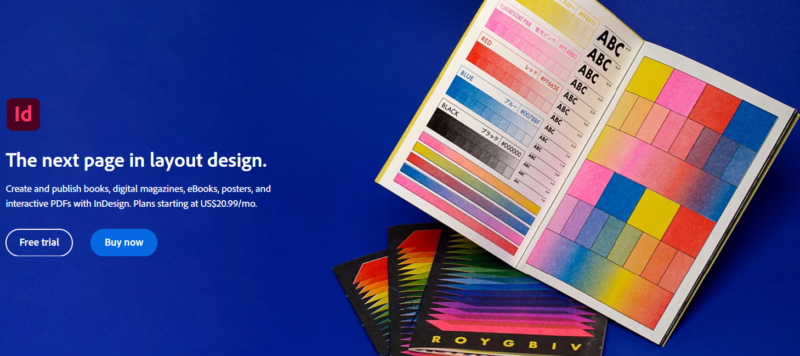
However, I can see InDesign working wonders for just about anyone and anything. Some of its use cases are:
- Flyers and posters
- Postcards
- eBooks & brochure
- Resume & cover letter
- Presentation, etc.
Moreover, InDesign has native collaboration capabilities to assist you with reviews and feedback and keep everyone important in the loop.
It’s compatible with the latest file formats like HEIC, JP2K, and WebP and is loaded with features like Auto Style to get it done quickly with minimum drag.
After Effects
Adobe After Effects is a tool for creating captivating motion graphics and animations. If you’re into Hollywood movies, chances are you’ve already seen something made with After Effects.
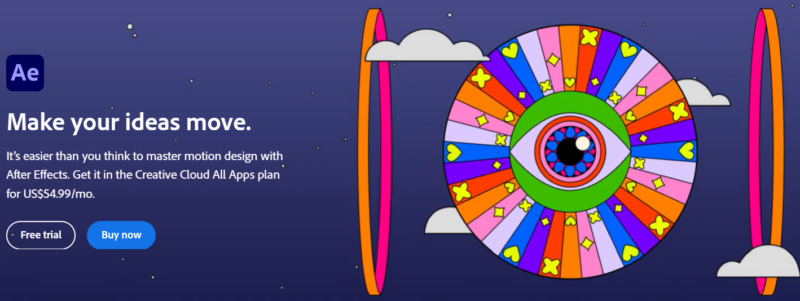
It’s used in:
- Text animation
- VFX
- Rotoscoping
- Motion tracking, etc.
As the name speaks, After Effects is a post-production tool. It’s often used to include or remove elements in a video that wasn’t originally there.
In addition, creators often bank on After Effects to induce artificial weather effects (rain, fire, etc.), graphic spinning & twirling, and use hundreds of effects made by other renowned designers.
Its rotoscoping is about removing undesired elements from a video and using them elsewhere with its content-aware fill. Similarly, motion tracking is used to track moving objects in any video and complement them with artificial elements.
Animate
Animations are everywhere. Movies, ads, social media, TV, etc., you name it, and there is hardly any public-facing media platform not already having at least a small flood of this genre.
Adobe Animate caters to this landscape and is a 2D animation tool jam-packed with features that you can benefit from to make your mark in this animation-dominated era.
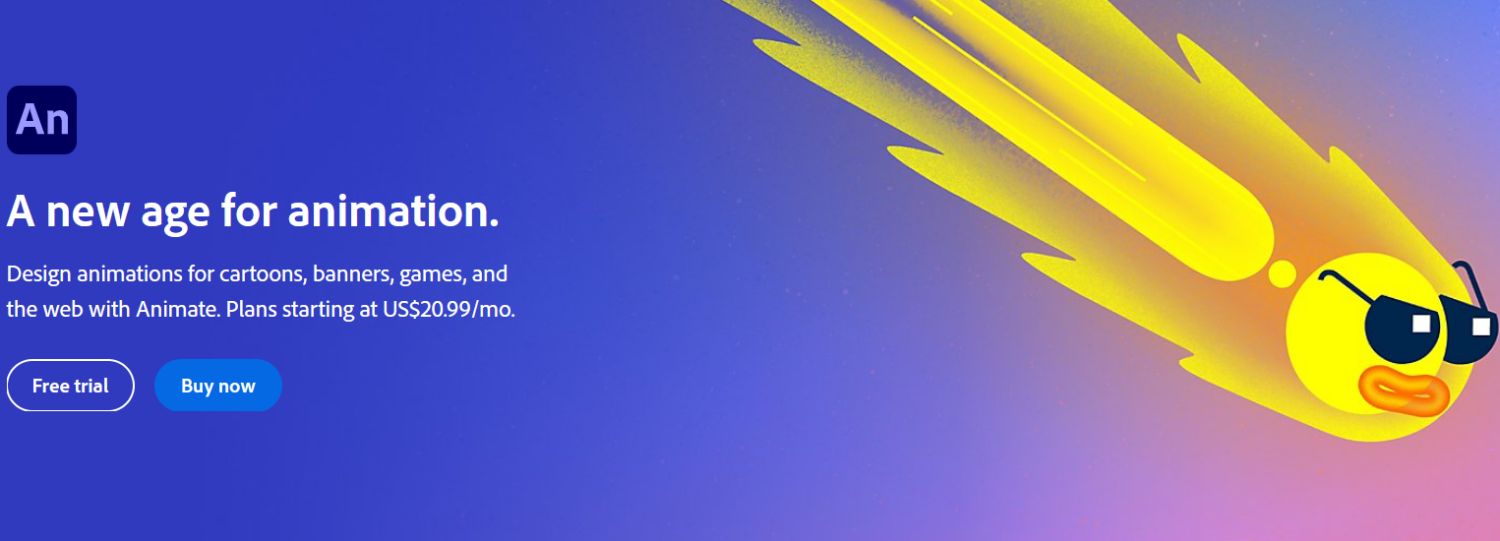
Animate supports frame-by-frame creations to bring your characters to life and make them do things like talking, walking, or anything you can imagine.
The best use case of Animate is creating gaming scenes and characters. Subsequently, one can combine them with matching audio and share them as augmented reality experiences.
However, you can also use Animate to create content for ads, movies, social media, cartoons, web design, and more.
Besides, it also supports native coding for ultimate design flexibility. Finally, Animate supports exporting in multiple formats, such as HTML5 Canvas, WebGL, Flash/Adobe AIR, and SVG.
Audition
Audition is Adobe’s attempt to get a slice of the audio editing industry. This software comes in handy while tweaking audio effects for podcasts, videos, games, music, etc.
Like most Adobe products, Audition also has plenty of preset effects, ranging from comical sounds, car horns, crowd noise, gunshots, laughs, whistles, and whatnot.
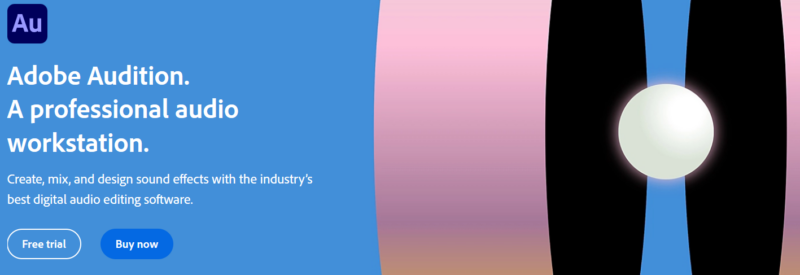
However, Audition is chiefly about audio modification. It integrates well with most audio equipment or plugins you might be using. In addition, you can create layered compositions with its multitrack editor or use its waveform editor to control audio amplitude.
Audition also lets you get rid of annoying background interferences and supports visual editing of the sound waves for a better output. Not just this, this audio editor has over 50 effects and mini-tools to get the final render the way you want.
Overall, Adobe has made this tool do wonders with every audio, and you can check this out individually or with the creative cloud package.
Other Apps
While we talked about some of Adobe Creative Cloud, it’s not limited to these apps. Instead, it has more, including:
Adobe Stock: A royalty-free library of media elements, including images, audio, video, vector art, illustrations, etc.
Lightroom: A lightweight tool for basic photo editing.
Character Animator: Bring life to animated characters with custom audio, motion, and gestures.
Dreamweaver: A software with an interactive coding engine that supports HTML, JavaScript, CSS, etc., for blazing-fast web design.
Now to the million-dollar question…
Why Adobe Creative Cloud?
See, there isn’t a fine line separating Adobe apps. They share some capabilities and shine working together. Even so, there is little sense in subscribing to Creative Cloud if all you want is a single Adobe app.
But let’s say one creator’s workflow is all about After Effects ($20.99/month), Illustrator ($10.49/month), and InDesign ($20.99/month), with a total monthly bill of $52.47/month.
Now that professional can stick to these three or add a few more dollars to get the complete suite for $54.99 a month.
There you have it. If you have an appetite for many Adobe tools, check the total amount you will eventually pay, and see if you want to have the whole package instead.
PS: Check out these free Adobe Software.
-
Hitesh works as a senior writer at Geekflare and dabbles in cybersecurity, productivity, games, and marketing. Besides, he holds master’s in transportation engineering. His free time is mostly about playing with his son, reading, or lying… read more
















